Contents
Raspberry Cascade Delight is one of the representatives of the “Cascade” line of berries. Although the variety was obtained back in 1993, it has only recently reached the CIS countries. Gardeners immediately became interested in the Cascade Delight variety, but not everyone managed to get along with it. The culture is characterized by demanding care. The variety is distinguished by large berries and is valued for its taste.
Inference history
The variety was bred as a result of hybridization of Chilliwack and WSU 994 species, which was carried out in 1989. In 1990, the obtained raspberry bushes were planted in a greenhouse, in 1993 test cultivations were carried out. The seedlings attracted selectors with appetizing berries and high yields.
The selection team was led by Dr. Patrick Moore. The raspberry originated in Washington state. The variety was registered in 2002. Two years later, it was patented.
Description of raspberry variety Cascade Delight
Cascade Delight is a medium ripening raspberry that came to Our Country from America. The variety is able to bear fruit on overwintered last year’s shoots. Having reached the age of three, the raspberry bush begins to develop more actively. At this time, he gives the maximum yield.
Berries
Large-fruited raspberry Cascade Delight has light, slightly empty berries of a bright scarlet color. Sometimes the fruits are covered with a weak white bloom. Raspberries have small, tightly fastened drupes, almost imperceptible seeds. During harvesting, the berries are easily separated from the bush, do not crumble.
The variety has good taste. The fruits are moderately sweet, have a refreshing taste characteristic of raspberries. Tight and dense berries are juicy, have a pleasant smell.
Raspberries take a conical shape, easily transfer transportation over long distances. Ripening begins in late June – early July.
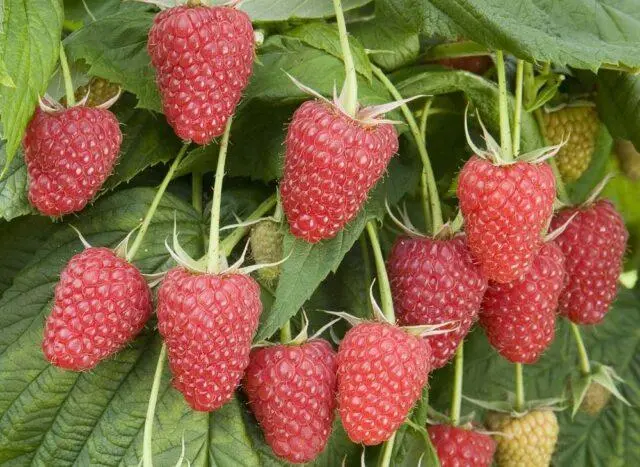
Raspberries are well stored, while the berries do not lose their smell and shape
Bush
Cascade Delight is actively growing. During the season, raspberries produce 10-12 stems. Strong branches can grow up to two meters. Young shoots are light green in color, turning brown-gray by autumn. During the fruiting period, they can turn red-lilac, covered with a whitish coating. Raspberries have strong, well-branched roots.
Most gardeners in the first few years of breeding Cascade Delight are faced with the problem of stunted bushes. In this case, you need to be patient, in a few years the raspberries will demonstrate their full potential. It is not recommended to allow thickening of plantings, it is better to remove excess sprouts, to carry out cleaning.
Raspberries have wide, corrugated, pointed leaves. Sometimes the cloves turn red-brown. The leaf reaches 13 cm in length, 6-8 cm in width. The color of the leaf plates from bright green can become lemon-green, this does not affect fertility.
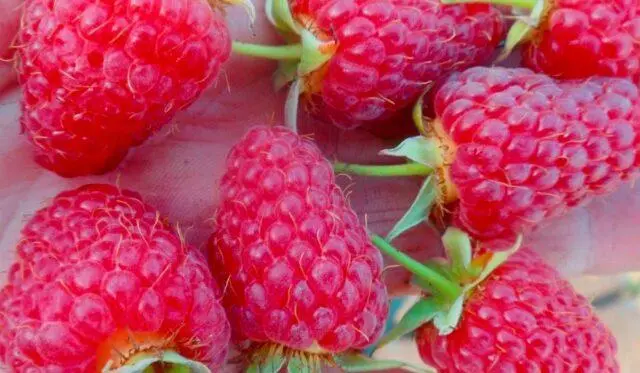
The leaves protect the raspberries from the scorching sun.
Characterization
Cascade Delight is a high yielding crop. Raspberries belong to the summer type of fruiting. It has a well-developed root system, therefore it is resistant to decay. The height of the shrub can reach three meters.
Ripening time and yield of raspberry Cascade Delight
Raspberry Cascade blooms at the end of May. Peduncles are collected in dense clusters. White flowers in width reach 2-2,5 cm, do not have a pronounced smell.
The fruits of the remontant raspberry Cascade Delight from the first harvest can weigh up to 9 g. With each subsequent wave, they become smaller. The average length of the fruit reaches 3-4 cm, width – 2-4 cm. Depending on the care, one raspberry bush can produce from 4 to 7 kg of crop.

With insufficient watering, the fruits lose their size, the taste indicators become worse.
Frost resistance
Cascade Delight is resistant to frost. Sometimes damage to the stems and buds is possible. For insurance for the winter, it is recommended to tie raspberry shoots into a pigtail and bend them to the ground. In regions with a cold climate, it is better to use agrofibre.
Resistance to diseases
Raspberry Cascade Delight is immune to various diseases and pests. The threat to the variety is raspberry aphid, and the dwarf virus it carries, which is transmitted through pollen. Sometimes a variety can infect root cancer. Wet and cool weather can lead to the development of gray mold.
To prevent diseases, it is recommended to purchase healthy seedlings and properly care for them.
Pros and cons of the variety
Raspberry Cascade Delight has a number of advantages and disadvantages. Gardeners appreciate it for its large-fruited, as well as for its high yield. The long fruiting period also attracts berry lovers.
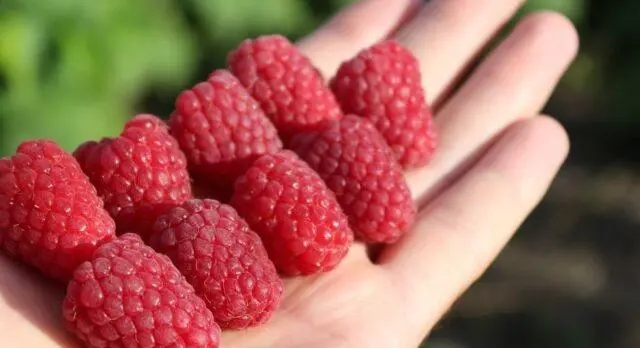
One of the advantages of Cascade Delight is the large size of the berries.
Pros:
- there are practically no thorns on the stems;
- seeds are small, imperceptible;
- high yield;
- ease of transportation;
- ability to grow on depleted soil;
- adaptability to various environmental conditions;
- attractive appearance;
- heat and frost resistance;
- slight detachment from the bush. The berries do not disintegrate, do not lose juice, and crumble on their own when ripe.
Cons:
- the size of the berries depends on the quality of watering;
- the variety often infects root cancer and aphids;
- bushes require regular pruning;
- good fertility occurs only in the third year after planting;
- uneven color of berries;
- foliage may turn yellow due to the sun;
- rain and cold adversely affect the taste and appearance of berries.
Features of growing raspberries Cascade Delight
Care and planting of the crop for the most part is no different from other varieties. It is enough to know a few nuances to grow a healthy plant and achieve a good harvest.
Rules of landing
The mother liquor needs to be bought only in nurseries, so the gardener will significantly increase the chance of a high yield. Seedlings should be purchased only with a closed root system. Before planting, it is recommended to choose a site, focusing on the type of soil. Loamy, sandy, acidic soils should be avoided. Increased soil acidity can be removed with flour or lime.
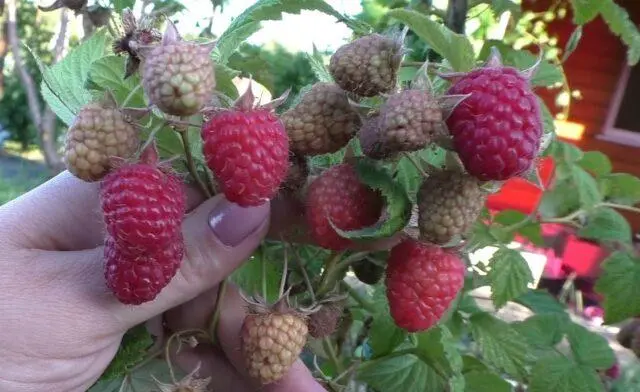
Raspberry should be located in a sunny, wind-free area
Prepare the site in the fall: remove weeds, dig up the ground, apply fertilizer. Seedlings should be located at a distance of 1-1,5 m from each other.
How to care
To get a good harvest, you need to know some secrets of growing a crop. Raspberry Cascade Delight care includes several requirements:
- sufficient level of watering;
- control of the number of shoots;
- top dressing;
- support for tall bushes;
- cutting the tips of the shoots;
- preparation for the winter period.
Raspberries need regular and moderate watering. Without it, the bushes do not grow well, in the heat the leaves turn yellow and die, the crop becomes sour.
Regarding top dressing: it is enough to apply fertilizer before planting. During the flowering of raspberries, you can add a small amount of mineral fertilizers, mullein or chicken manure.
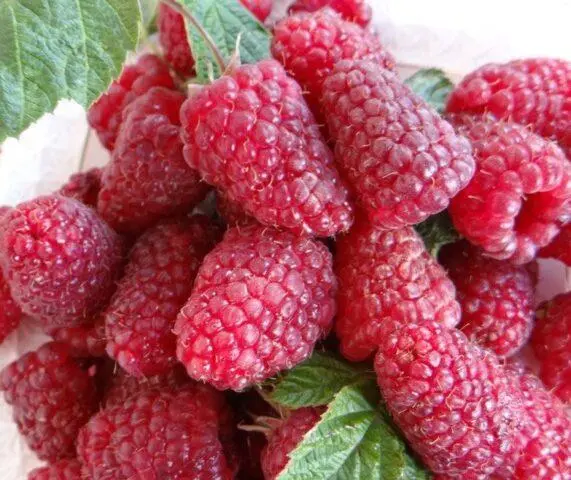
Nutrient compositions favorably affect the development of berries.
When the bushes get too tall, they are recommended to be supported with wire trellises. If the raspberry stalks reach a height of 1 meter, they can be pinched.
Prevention of diseases and pests
To achieve a plentiful and regular harvest, bushes are recommended to be fertilized with balanced mixtures, protected from diseases and pests. Raspberry Cascade responds well to organic soil additives. It is recommended to plow into the ground and mulch raspberry plantings with beveled green manure, yellow or white mustard.
If signs of infection are detected, it is permissible to treat the bushes with fungicides, for example, Fitosporin. Spraying with drugs is carried out before the formation of fruits.
In early spring, the bushes can be treated with Bordeaux liquid, copper sulfate. This will protect the plant not only from diseases, but also from pests.
Conclusion
Raspberry Cascade Delight is a good choice for both experienced and beginner gardeners. The plant, when properly handled, produces a bountiful harvest of delicious berries. Raspberries can be eaten raw, made into decoctions, dried.









